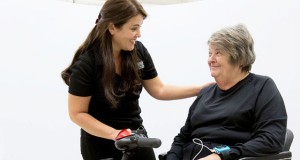|
After diabetes took part of her left leg, Jackie Smith, 66, worried whether she would ever regain her mobility with a prosthetic foot that felt stiff and awkward.
But her experience wearing a more technologically advanced prosthesis under the eye of Nicoleta Bugnariu, PhD, PT, has the Arlington amputee imagining an independent future.
“I can turn easily again and keep my balance,” Smith said. “I was flabbergasted.”
Dr. Bugnariu and her team in the Human Movement Performance laboratory are conducting a research study that could improve the quality of life for lower-limb amputees everywhere by changing the way prostheses are prescribed. Early results recently earned an award from the American Orthotic and Prosthetic Association.
After an amputation, patients are classified based on their functional abilities. A K2 classification means they have limited mobility, while K3 represents basic to normal mobility. Each amputee is then prescribed a prosthesis that fits his or her classification. A K3 prosthesis is more technologically advanced and expensive than a K2 prosthesis. |







Social media